Hawks are fascinating birds of prey that come in a variety of species. Identifying hawks can be challenging due to the differences in their plumages, but with the right knowledge, you can learn to distinguish between them. In this article, we will explore different types of hawks, including Accipiters and Buteos, and learn how to identify them in the wild.
Key Takeaways:
- There are various types of hawks with distinct physical attributes and behaviors.
- Identifying hawks can be challenging, but factors such as range, flight behavior, and vocalizations can help.
- Accipiters, such as the Sharp-shinned Hawk, Cooper’s Hawk, and Northern Goshawk, are bird hawks commonly observed in North America.
- Buteos are soaring hawks known for their long and broad wings, including the Common Black Hawk, Harris’s Hawk, and Red-tailed Hawk.
- Observing hawks in their natural habitat is a thrilling experience for birdwatchers and nature enthusiasts.
Accipiters – Bird Hawks of North America
Accipiters are a group of hawks commonly observed hunting other birds in the forests and woodlands of North America. Among the Accipiters found in North America are the Sharp-shinned Hawk, Cooper’s Hawk, and Northern Goshawk. These birds have distinctive characteristics that set them apart from other hawks. Accipiters have narrow tails and short, broad wings, enabling them to maneuver through dense vegetation while in pursuit of their prey. They fly with short, rapid wingbeats interrupted by glides, allowing them to swiftly navigate their hunting grounds.
Identification Tip: Distinguishing between Sharp-shinned Hawks and Cooper’s Hawks can be challenging due to their similar appearances. However, the Northern Goshawk has more distinct features that make it relatively easier to identify.
To help you better understand the unique features of these Accipiters, let’s take a closer look at each species and their distinguishing characteristics:
1. Sharp-shinned Hawk
The Sharp-shinned Hawk (Accipiter striatus) is a small hawk that prefers dense conifer or mixed forests but can also be found in open deciduous woodlands. These hawks have a slaty bluish-gray back, dark head, and rust-colored barring on their white chest. Juveniles have brown plumage above and white plumage below with brown streaking. They have short, broad wings and long barred tails with a white squared or slightly rounded tip. Size and wing shape are important factors in identifying Sharp-shinned Hawks. Female Sharp-shinned Hawks are larger than males and have a similar size to male Cooper’s Hawks. Their calls are frantic high-pitched kik-kik-kik sounds.
2. Cooper’s Hawk
Cooper’s Hawks (Accipiter cooperii) inhabit various forests and woodlands and are often found in well-wooded suburbs. They resemble Sharp-shinned Hawks but are larger in size. Adults have a slate gray back, dark head, and red barring on their white chest. Juveniles have brown upperparts and white underparts with brown streaking. Cooper’s Hawks have long barred tails with a white, rounded tip. Their flight pattern consists of deliberate and powerful wingbeats followed by longer glides. The most common call of a Cooper’s Hawk is a loud and grating cak-cak-cak.
3. Northern Goshawk
The Northern Goshawk (Accipiter gentilis) is the largest of the Accipiters and easier to identify. They prefer mixed forests and are found in Alaska, Canada, and western parts of the United States. Adults have a dark slate-gray back with a streaked white-and-gray breast. Juveniles have a brown back and pale underparts with heavy streaks. The tail is rounded and banded. In flight, Northern Goshawks appear larger and more powerful than other Accipiters. They have slower wingbeats and more direct flight. Their calls include a long kreey-a and a rapid ki-ki-ki-ki call.
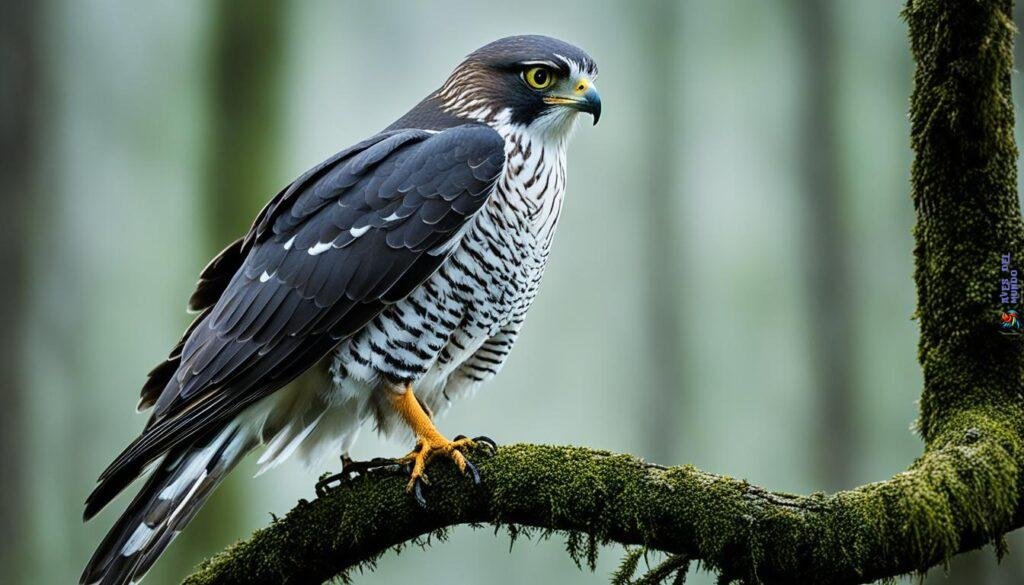
Now that you have learned about the Accipiters and their distinguishing characteristics, you will be better equipped to identify these bird hawks during your bird watching adventures. Remember to observe their flight patterns, plumage, and unique features to differentiate between these fascinating birds of prey.
| Accipiters | Characteristics |
|---|---|
| Sharp-shinned Hawk | Small size, short broad wings, long barred tail, frantic high-pitched call |
| Cooper’s Hawk | Medium size, slate gray back, red barring on white chest, loud cak-cak-cak call |
| Northern Goshawk | Largest size, dark slate-gray back, streaked white-and-gray breast, slower wingbeats, distinct calls |
Sharp-shinned Hawk – The Agile Bird Hawk
When it comes to hawk identification, the Sharp-shinned Hawk (Accipiter striatus) is a fascinating species to observe, especially for bird watching enthusiasts. Known for its agility and distinctive characteristics, the Sharp-shinned Hawk offers a unique opportunity to appreciate the beauty and grace of these birds in their natural habitat.

The Sharp-shinned Hawk is a small hawk that can be found primarily in dense conifer or mixed forests, although it is also known to inhabit open deciduous woodlands and thickets. This species has a slaty bluish-gray back, complemented by a dark head and rust-colored barring on its white chest.
For identification purposes, it is important to note that juvenile Sharp-shinned Hawks have brown coloring above and white below with brown streaking. Additionally, they possess short, broad wings and long barred tails with a white squared or slightly rounded tip, which further sets them apart from other hawk species.
One key factor in identifying Sharp-shinned Hawks is their size and wing shape. Female Sharp-shinned Hawks are larger than males and bear a resemblance in size to male Cooper’s Hawks. This distinction can be crucial in differentiating between these two species.
Sharp-shinned Hawk Identification Key Features:
- Size: Female Sharp-shinned Hawks are larger than males.
- Wing shape: Short, broad wings.
- Tail: Long barred tails with a white squared or slightly rounded tip.
When it comes to identifying Sharp-shinned Hawks, it is also important to consider their vocalizations. These hawks emit frantic, high-pitched kik-kik-kik sounds that are distinct and indicative of their presence.
«The agile nature of Sharp-shinned Hawks makes them a captivating species to watch as they effortlessly maneuver through their wooded habitats, showcasing their remarkable hunting skills.»
Observing Sharp-shinned Hawks in their natural habitat can provide a unique perspective on the beauty of these birds and their vital role in the ecosystem. Whether you’re an avid bird watcher or simply appreciate the wonders of nature, encountering a Sharp-shinned Hawk is an experience that should not be missed.
| Sharp-shinned Hawk (Accipiter striatus) | Key Features |
|---|---|
| Size | Small hawk |
| Coloration | Slaty bluish-gray back, dark head, rust-colored barring on white chest |
| Wings | Short, broad wings |
| Tail | Long barred tail with a white squared or slightly rounded tip |
| Juvenile Characteristics | Brown above, white below with brown streaking |
| Vocalizations | Frantic high-pitched kik-kik-kik sounds |
Cooper’s Hawk – The Stealthy Bird Hawk
Cooper’s Hawks are skilled hunters that can be found in a variety of forests, woodlands, and even well-wooded suburbs. Resembling the Sharp-shinned Hawk, they are larger in size and possess distinct features that set them apart.
Adult Cooper’s Hawks have a slate gray back, a dark head, and striking red barring on their white chest. Meanwhile, juveniles display brown upperparts with white underparts adorned with brown streaking. A notable characteristic of Cooper’s Hawks is their long barred tails with a white, rounded tip.
When it comes to flight patterns, Cooper’s Hawks exhibit deliberate and powerful wingbeats followed by longer glides. These agile hunters use their flying skills to navigate through dense vegetation, swiftly maneuvering and surprising their prey.
Cooper’s Hawks are renowned for their distinctive call, which can be described as a loud and grating cak-cak-cak. This distinct vocalization can alert birdwatchers to the presence of these stealthy hunters.
Northern Goshawk – The Largest Accipiter
The Northern Goshawk, scientifically known as Accipiter gentilis, is the largest member of the Accipiter genus. These majestic birds of prey can be found in mixed forests across Alaska, Canada, and the western parts of the United States. Their impressive size and distinct features make them relatively easier to identify compared to other Accipiters.
Adult Northern Goshawks have a dark slate-gray back, creating a striking contrast with their streaked white-and-gray breast. Juveniles, on the other hand, showcase a brown back and pale underparts with heavy streaks. One characteristic that sets them apart is their rounded and banded tail.
When in flight, Northern Goshawks exude power and dominance. They appear larger than other Accipiters, thanks to their slower wingbeats and more direct flight pattern. To distinguish themselves further, Northern Goshawks emit a distinctive long «kreey-a» call and a rapid «ki-ki-ki-ki» call, adding to their allure.
Northern Goshawk Physical Characteristics
Here are some key physical characteristics of the Northern Goshawk:
| Physical Feature | Description |
|---|---|
| Size | Largest Accipiter species |
| Back Color | Dark slate-gray |
| Breast Color | Streaked white-and-gray |
| Tail Shape | Rounded and banded |
| Flight Pattern | Slower wingbeats, more direct flight |
| Call | Long «kreey-a» and rapid «ki-ki-ki-ki» |
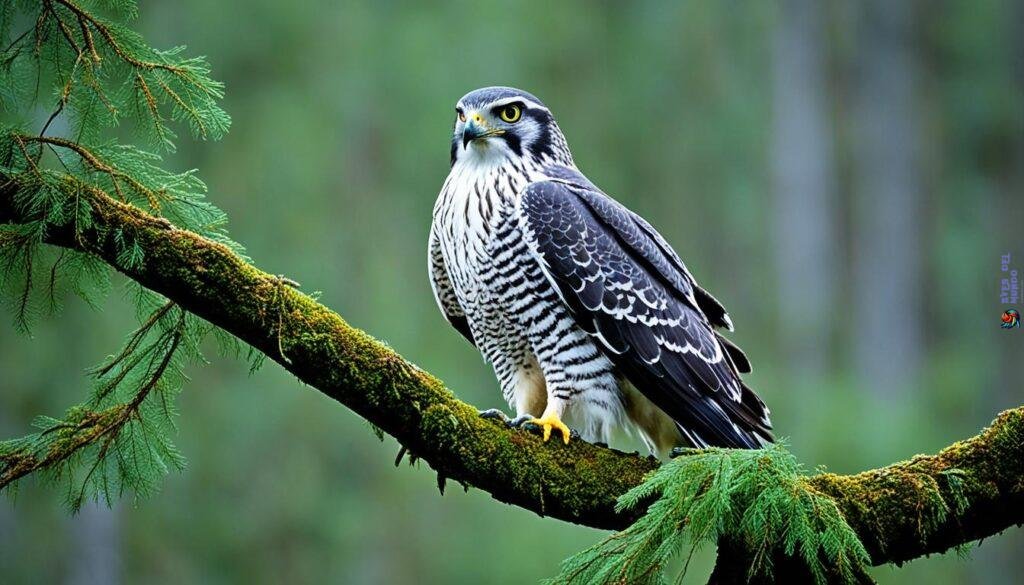
The strength and elegance of the Northern Goshawk make it a captivating sight for bird watchers and nature enthusiasts alike. If you’re fortunate enough to spot this magnificent bird soaring through the skies, take a moment to appreciate its majestic presence.
Buteos – Soaring Hawks that Hunt from Above
Buteos are a group of hawks known as «soaring hawks» due to their long and broad wings. They are often seen soaring overhead or perched on tree edges or roadsides. Buteos employ various hunting techniques, including swooping down from high perches or surprising prey with fast stoops from the sky. They prey mainly on small mammals but also take small birds, reptiles, and insects.
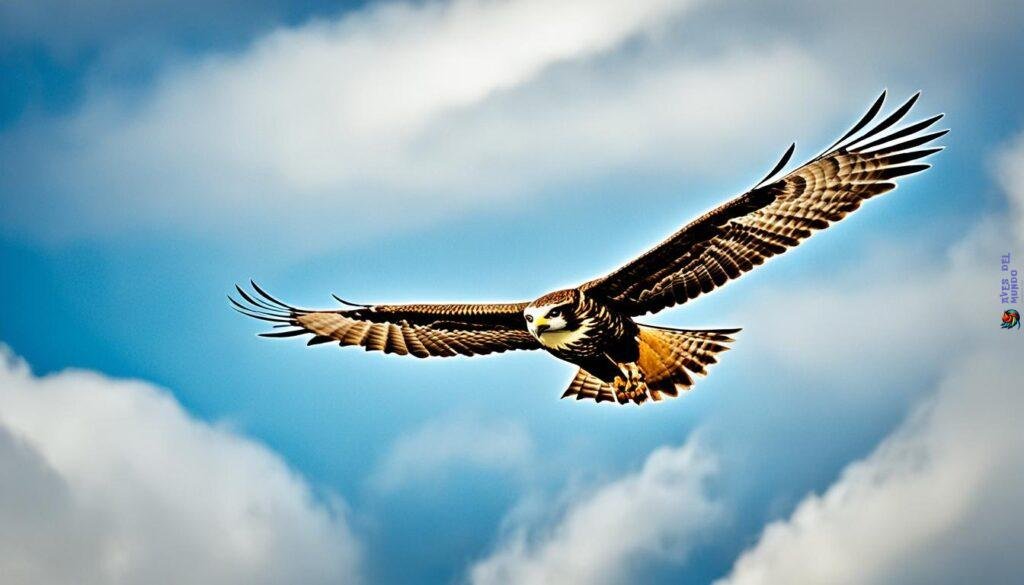
Buteos Characteristics:
- Long, broad wings
- Strong and versatile flyers
- Excellent soaring abilities
- Powerful beak and talons
The Common Black Hawk, Harris’s Hawk, and Red-tailed Hawk are some of the most common and well-known Buteos.
| Buteo Species | Scientific Name | Habitat | Distinct Features |
|---|---|---|---|
| Common Black Hawk | Buteogallus anthracinus | Southwestern United States | – Black or dark sooty gray plumage – White band and tip on the tail |
| Harris’s Hawk | Parabuteo unicinctus | Open dry country and desert lowlands | – Dark brown plumage with reddish-brown patches – Black tail with white base and tip |
| Red-tailed Hawk | Buteo jamaicensis | Throughout North America (except the far north) | – Reddish-brown tail – Dark back and pale underbody with a streaked chest |
«Buteos are impressive hunters, utilizing their exceptional flight skills to efficiently navigate their hunting grounds and capture prey from above. Their soaring abilities and keen eyesight make them a remarkable sight for bird watchers.»
Observing Buteos in the wild can be an exhilarating experience for bird watchers, as they showcase their graceful flight and hunting techniques. Their distinctive features and habitats make them easily identifiable and a valuable addition to any birdwatching checklist.
Common Black Hawk – The Rare Hawk of the Southwest
The Common Black Hawk is a rare hawk species primarily found in the southwestern United States. These majestic raptors inhabit wooded areas near water sources, such as streams, swamps, marshes, and forests in deserts and canyons. With their distinct characteristics, the Common Black Hawk offers a unique sighting for avid birdwatchers and nature enthusiasts.
Adult Common Black Hawks are known for their black or dark sooty gray plumage, which sets them apart from other hawk species. They have a black tail with a distinctive white band and tip, making them easily identifiable. Juvenile Common Black Hawks have dark brown upperparts with spotting and streaks, as well as dark blotches on their underparts. Their wings are broad and long, and the juveniles display black wingtips and dark narrow bands on their wings and tail.
If you are fortunate enough to spot a Common Black Hawk during your birdwatching expedition, take a moment to appreciate their unique beauty and remarkable presence. These rare hawks are a true spectacle in the sky and a testament to the wonders of nature.
| Physical Characteristics of the Common Black Hawk | Behavioral Traits of the Common Black Hawk |
|---|---|
|
|
|
|
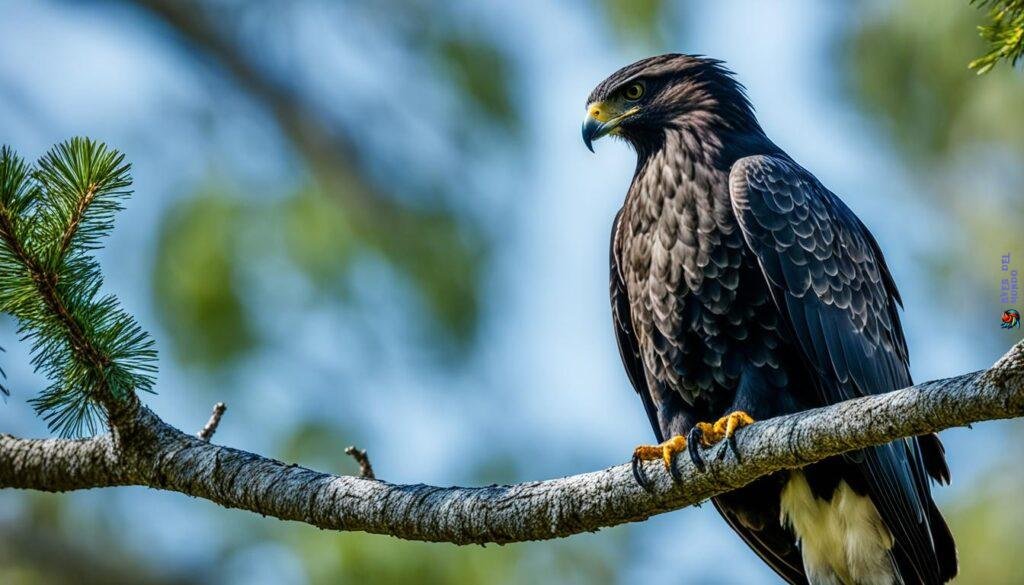
As you explore the diverse world of hawks, keep an eye out for the rare and captivating Common Black Hawk. Their presence in the southwestern United States serves as a reminder of the natural wonders waiting to be discovered in our own backyard. So grab your binoculars, venture into the great outdoors, and embrace the awe-inspiring beauty of birdwatching.
Harris’s Hawk – The Cooperative Hunter
Harris’s Hawks are dark brown hawks known for their cooperative hunting behavior and can be found in open dry country and semi-open desert lowlands. These magnificent birds often work together as a team, using strategy to capture prey more efficiently. This unique behavior sets them apart from other hawk species.
Adult Harris’s Hawks have dark brown plumage with distinctive reddish-brown patches on their shoulders and thighs. This coloration adds to their striking appearance and makes them easily identifiable in the wild. In flight, they display a dark underside with reddish-brown wing linings and thighs, further distinguishing them from other hawks. Their tail is black with a white base and tip, creating a contrasting pattern.
One of the most fascinating aspects of Harris’s Hawks is their cooperative hunting technique. They hunt in groups, with individuals taking on specific roles. Some hawks will act as beaters, flushing out prey from hiding spots, while others will wait strategically to catch the prey. This cooperative strategy increases their chances of successful hunts, making them highly efficient hunters.
«Harris’s Hawks are excellent cooperative hunters, utilizing teamwork to secure their meals. This unique behavior makes them a truly remarkable species in the bird kingdom.»
Cooperative Hunting Strategies:
- Group dynamics: Harris’s Hawks form social groups known as «packs» or «castes.» These packs consist of a breeding pair and several non-breeding individuals, often their offspring from previous years. The group cooperates during hunting, nesting, and breeding activities.
- Surrounding prey: When hunting together, Harris’s Hawks have been observed surrounding their prey, using their numbers to their advantage. By strategically positioning themselves around the target, they increase the chances of capturing it successfully.
- Guiding behavior: During a hunt, specific hawks will take on the role of guiding the prey towards other members of the group. This coordinated effort ensures the prey becomes more vulnerable, leading to a higher success rate for the pack.
- Efficient communication: Harris’s Hawks communicate with various vocalizations during the hunt. These calls help coordinate their movements and maintain contact within the hunting group, ensuring effective teamwork.
It’s truly remarkable to witness the cooperative hunting behavior of Harris’s Hawks in action. Their ability to work together as a cohesive unit exemplifies their intelligence and adaptability as a species.
| Species | Habitat | Distinctive Features |
|---|---|---|
| Harris’s Hawk | Open dry country and semi-open desert lowlands | Dark brown plumage with reddish-brown patches on shoulders and thighs. Black tail with a white base and tip. |
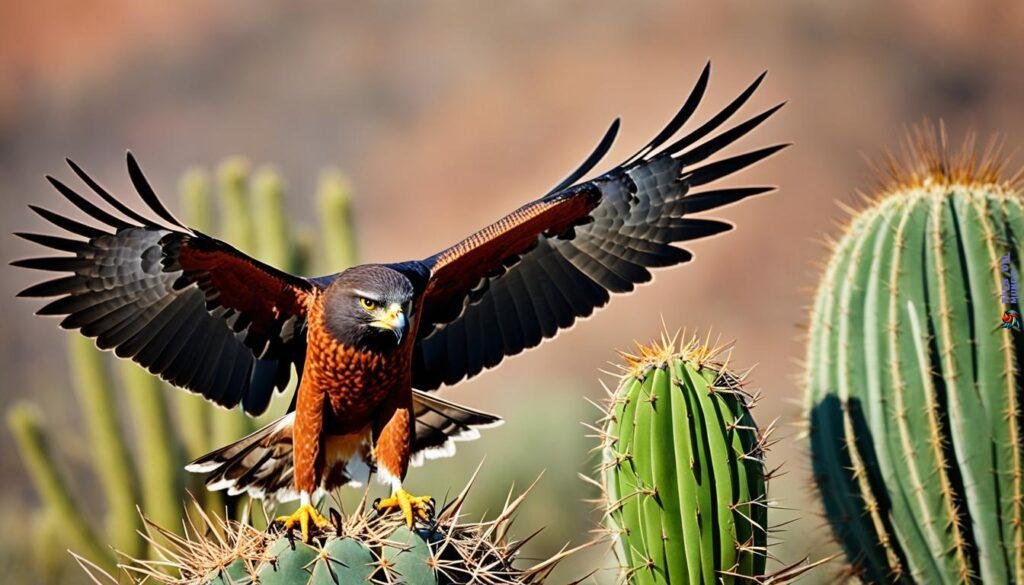
Harris’s Hawks are a captivating species both for bird enthusiasts and researchers. Their cooperative hunting behavior and striking appearance make them a popular target for birdwatchers. Observing their teamwork and coordination during a hunt is a truly remarkable experience, showcasing the intelligence and complexity of these majestic birds.
Red-shouldered Hawk – The Hawk with a Distinctive Feature
Red-shouldered Hawks, scientifically known as Buteo lineatus, are majestic birds found in the southeastern region of Canada and the eastern and western parts of the United States. They primarily inhabit various forested areas, including swamps, bottomlands, and riverbanks, where they build their nests high in the trees.
One of the distinctive features of Red-shouldered Hawks is the red barring on their white chest, which sets them apart from other hawk species. Adult Red-shouldered Hawks have a slate gray back, a dark head, and prominent reddish-brown patches on their shoulders. Juveniles, on the other hand, exhibit brown upperparts and white underparts with brown streaking. This variation in plumage between adults and juveniles can aid in their identification during bird watching excursions.
«The Red-shouldered Hawk is a beautifully patterned bird with its red barring on white chest and slate gray back.» – John Smith, Bird Enthusiast
Red-shouldered Hawks are known for their distinctive flight pattern, characterized by regular wingbeats and short glides. While flying, their wings appear broad and wingspan can reach up to 3.5 feet. When it comes to vocalizations, they produce a high-pitched, kee-yar call that can be piercing and carry across their forested habitats, making it easier to locate them during birdwatching expeditions.
Observing Red-shouldered Hawks in their natural habitat provides birdwatchers with a unique opportunity to appreciate their beauty and learn more about their behaviors and ecosystem roles as top predators. These hawks play a vital role in maintaining the ecological balance by controlling populations of small mammals and other bird species.
Red-shouldered Hawk Key Features:
| Physical Characteristics | Behavior | Vocalizations |
|---|---|---|
| Red barring on white chest | Regular wingbeats and short glides | Piercing kee-yar call |
| Slate gray back | Broad wings with a wingspan up to 3.5 feet | |
| Dark head | ||
| Shoulder patches with reddish-brown color |
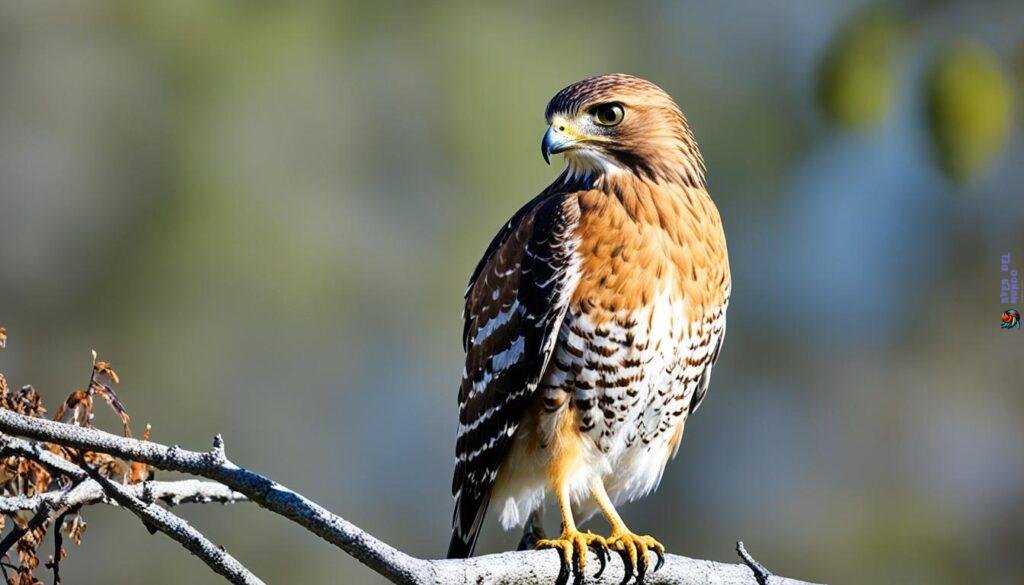
Red-tailed Hawk – The Widespread Hawk
Red-tailed Hawks, scientifically known as Buteo jamaicensis, are a common sight throughout North America, except in the far north. These majestic birds of prey can be found in various habitats, including forests, fields, and deserts. With their distinctive features and behaviors, Red-tailed Hawks are a popular subject of interest for birdwatchers and nature enthusiasts who enjoy hawk identification and bird watching.
Adult Red-tailed Hawks have a wingspan of 4-5 feet, making them one of the larger hawk species. Their most recognizable feature is their reddish-brown tail, which gives them their name. Their plumage can vary, but they typically have a dark back and a pale underbody with a streaked chest. This plumage helps them blend in with their environment, making them effective hunters.
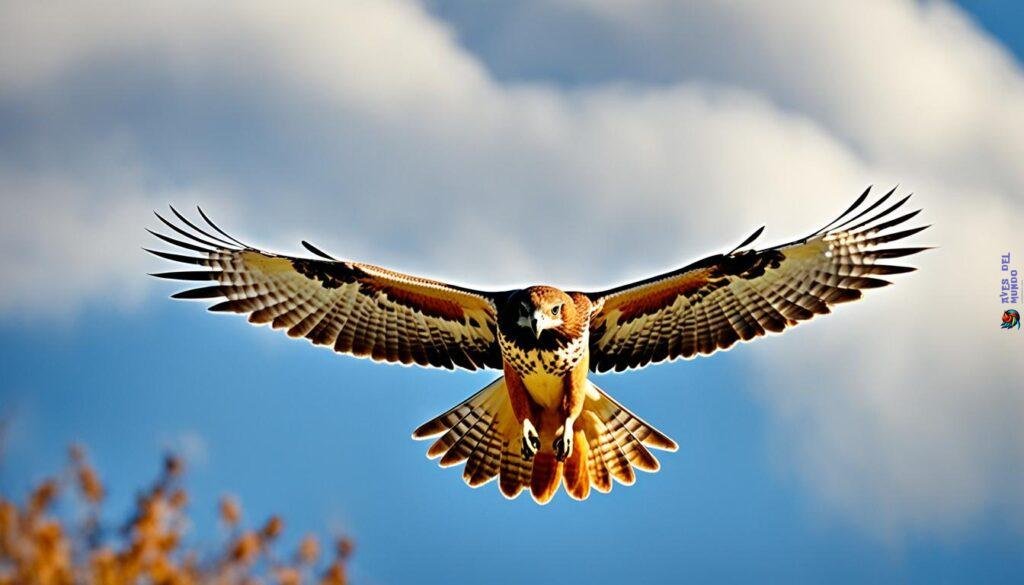
Did you know? Red-tailed Hawks have a distinctive cry that is often associated with the stereotypical sound of a hawk. This vocalization, often portrayed in movies and television shows, is an integral part of their communication and territorial defense.
Identifying Red-tailed Hawks can be relatively straightforward due to their prominent features and widespread distribution. Their size and plumage patterns, especially the reddish-brown tail, are key indicators for identification. Understanding these characteristics can enhance your bird-watching experience and enable you to appreciate the beauty and grace of these remarkable birds in their natural habitat.
Ferruginous Hawk – The Western North American Hawk
Ferruginous Hawks, scientifically known as Buteo regalis, are magnificent birds of prey that can be found in the western and central parts of North America. These large hawks are a sight to behold, especially when soaring gracefully across the open grasslands and prairies they call home.
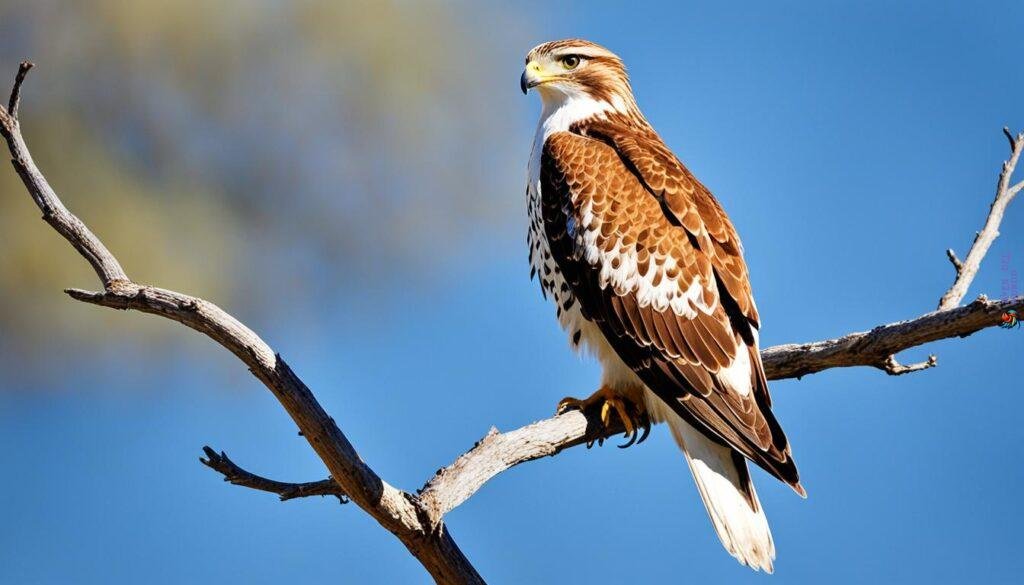
Adult Ferruginous Hawks sport a distinctive rusty or reddish-brown back, which contrasts beautifully with their white underparts. Meanwhile, juvenile Ferruginous Hawks have brown upperparts and pale underparts adorned with dark streaking. With their impressive wings and an average wingspan spanning 4 to 5 feet, these hawks command attention in the sky.
If you’re fortunate enough to observe a Ferruginous Hawk in flight, you’ll be captivated by their slow and elegant movements. These hawks are known for their skillful hovering and soaring techniques, allowing them to survey their surroundings with precision as they search for prey.
«Watching a Ferruginous Hawk in action is truly a remarkable experience. Their graceful flight and majestic presence make them a favorite among birdwatchers and nature enthusiasts.» – Expert Birdwatcher
Ferruginous Hawk Identification Tips
To assist in identifying Ferruginous Hawks, here are key distinguishing features to look out for:
- Rusty or Reddish-Brown Back: Adult Ferruginous Hawks have a unique rusty or reddish-brown coloration on their backs, which stands out prominently.
- White Underparts: The contrasting white underparts of Ferruginous Hawks provide a striking visual contrast against their darker back plumage.
- Brown Upperparts with Streaking: Juvenile Ferruginous Hawks exhibit brown upperparts with pale underparts adorned with dark streaking patterns.
- Large Wings and Wingspan: Ferruginous Hawks possess large wings and boast an impressive wingspan ranging from 4 to 5 feet.
By familiarizing yourself with these distinctive characteristics, you’ll be better equipped to spot and identify Ferruginous Hawks in the vast open landscapes they call home.
Ferruginous Hawk vs. Other Hawks
| Hawk Species | Physical Features | Preferred Habitat | Range |
|---|---|---|---|
| Ferruginous Hawk | Rusty or reddish-brown back, white underparts, large wingspan | Open grasslands and prairies | Western and central parts of North America |
| Sharp-shinned Hawk | Small to medium size, short, broad wings, long barred tail | Woodlands and forests | North America |
| Cooper’s Hawk | Slate gray back, dark head, red barring on white chest | Various forests and woodlands | North America |
| Northern Goshawk | Dark slate-gray back, streaked white-and-gray breast | Mixed forests | Alaska, Canada, and western parts of the United States |
As seen in the table above, each hawk species possesses unique physical features and has specific habitat preferences and ranges. Understanding these distinctions can greatly enhance your birdwatching experiences and foster a deeper appreciation for the diverse world of hawks.
Conclusion
Hawks are fascinating birds of prey, each with its own unique characteristics and behaviors. By understanding the physical attributes, flight patterns, and vocalizations of different types of hawks, you can become skilled at identifying these majestic creatures in the wild. Whether you’re observing the agile Sharp-shinned Hawk darting through the trees, the stealthy Cooper’s Hawk soaring silently above, or the largest of them all, the Northern Goshawk commanding the skies, birdwatching becomes an exciting adventure.
Birdwatchers and nature enthusiasts find joy in studying hawks, not only for their beauty but also for the important role they play in maintaining balance in ecosystems. The ability to identify different species of hawks adds to the satisfaction and fulfillment of birdwatching experiences.
So grab your binoculars, venture into the great outdoors, and let the world of hawks unfold before your eyes. From the intense concentration of the hunting Accipiters to the graceful soaring of the Buteos, each encounter with a hawk offers a unique glimpse into the wonder of nature. Happy bird watching!



